Pan-Sharpening of Landsat-8 Images and Its Application in Calculating Vegetation Greenness and Canopy Water Contents
Abstract
:1. Introduction
- The Intensity, Hue, Saturation (IHS) method, which is described as the conversion of color image from RGB (Red, Green, Blue) space into the IHS color space [18,19]. Because the intensity band resembles a PAN image in the fusion, a reverse IHS transform is then performed on the PAN together with the hue and saturation bands, resulting in an IHS fused image. When the PAN band is not highly correlated with the low spatial resolution bands, then the radiometric distortion of the color composite is quite obvious [20]. Typically, this method uses the high-resolution PAN image to replace the intensity component and obtains the fused image by applying an inverse IHS transform [21].
- The Principal Component Analysis (PCA) transform converts inter-correlated MS bands into a new set of uncorrelated components [22,23,24]. The first component also resembles a Pan image. It is, therefore, replaced by a high spatial resolution Pan for the fusion. The Pan image is fused into the low spatial resolution MS bands by performing a reverse PCA transform.
- The Brovey Transform (BT), Synthetic Variable Ratio (SVR), and Ratio Enhancement (RE) techniques are also used with a mathematical combination of the color image and high resolution data [25]. The procedures of the Brovey Transform first multiplies each MS band by the high resolution PAN band and then divides each product by the sum of the MS bands. The SVR and RE techniques are similar but involve more sophisticated calculations for the MS sum for better fusion quality. Usually, the Brovey transform, SVR, and RE have been developed to visually increase contrast in the low and high ends of an image’s histogram. In general, BT is a combination of arithmetic operations and it needs to normalize the spectral bands before they are multiplied with the PAN band [26,27].
- In wavelet fusion, a high spatial resolution Pan image is first decomposed into a set of low resolution Pan images with corresponding wavelet coefficients (spatial details) for each level [11,28]. Individual bands for the MS image then replace the low spatial resolution Pan at the resolution level of the original MS image. The high resolution spatial detail is injected into each MS band by performing a reverse wavelet transform on each MS band together with the corresponding wavelet coefficient.
- In UNB pan sharp, the algorithm utilises the least squares technique to find the best fit between the grey values of the PAN and the MS bands to adjust the contribution of individual bands to the fusion result [29]. It usually employs a set of statistical approaches to estimate the grey value relationship between all the input bands to eliminate the problem of data dependency.
- The Smoothing Filter-based Intensity Modulation (SFIM) fusion algorithm points out that by using a ratio between a higher resolution image and its low-pass filtered (with a smoothing filter) image, spatial details can be modulated to a co-registered lower resolution MS image without altering its spectral properties and contrasts [28].
- Other methods are also incorporated in literature with special emphasis on local mean and variance matching (LMVM); least square fusion methods, local mean matching fusion method, and the Gram-Schimdt fusion method. All of these techniques have been used to increase the spatial and spectral resolution of MS bands using PAN band [18,30].
2. Study Area and Data Requirements
3. Methods
3.1. Collection of Landsat-8 OLI Data and Evaluation of the Relationships among MS and Pan Bands
3.2. Data Fusion (Pan-Sharpening)
3.3. Generation of Vegetation and Canopy Moisture Contents and Their Validation
4. Results and Discussion
4.1. Comparing and Determining Relationships among PAN and MS Bands
4.2. Generation of Vegetation and Canopy Moisture Contents and Their Validation
4.3. Contributions
- (i)
- To our knowledge of the contemporary literature, comparison and/or correlation analysis between pan-sharpened NDVI, EVI, and NDWI products (@15 m spatial resolution) with their original spatial resolution (@30 m spatial resolution) had not been reported elsewhere;
- (ii)
- Landsat-8 OLI is a relatively newly launched satellite platform (operating since February 2013) [16]. The PAN band of this particular satellite differs from others. For example, the spectral resolution of the PAN band spans 0.503–0.676 µm with clearly no overlap with the blue, and NIR spectral bands. Note that other platforms, on the other hand, have overlapping spectral bands between PAN, and visible, and NIR bands. As a result, we assumed that the PAN band of the Landsat-8 should not be correlated with the NIR band, which, in fact, was proven in this study.
- (iii)
- Other studies [38,39,40,41] applied pan-sharpening over Landsat-8 data in order to derive NDVI-values alone. In these studies, we understood that they also pan-sharpened the NIR band, which might not be applicable to enhance vegetation indices as the relationship between the PAN and NIR band could not be significant. We thus mentioned in this study that NIR band would not yield better results if used in further enhancement of vegetation indices.
- (iv)
- We also calculated EVI (an indicator of vegetation canopy structure), and NDWI (an indicator of water stress of vegetation) using Landsat-8 OLI data and provided their validations.
5. Concluding Remarks
Acknowledgments
Author Contributions
Conflicts of Interest
References
- Zhang, J. Multi-source remote sensing data fusion: Status and trends. Int. J. Image Data Fusion 2010, 1, 5–24. [Google Scholar] [CrossRef]
- Vivone, G.; Alparone, L.; Chanussot, J.; Mura, M.D.; Garzelli, A.; Member, S.; Licciardi, G.A.; Restaino, R.; Wald, L. Pansharpening Algorithms. IEEE Trans. Geosci. Remote Sens. 2014, 53, 2565–2586. [Google Scholar] [CrossRef]
- Laben, C.; Brower, B. Process for Enhancing the Spatial Resolution of Multispectral Imagery Using Pan-sharpening. U.S. Patent 6011875 A, 29 April 1998. [Google Scholar]
- Jovanović, D.; Govedarica, M.; Sabo, F.; Važić, R.; Popović, D. Impact analysis of pansharpening Landsat ETM+, Landsat OLI, WorldView-2, and Ikonos images on vegetation indices. Procceedings of the Fourth International Conference on Remote Sensing and Geoinformation of the Environment, Paphos, Cyprus, 4 April 2016. [Google Scholar]
- Bhatti, S.S.; Tripathi, N.K. Built-up area extraction using Landsat 8 OLI imagery. GIsci. Remote Sens. 2014, 51, 445–467. [Google Scholar] [CrossRef]
- Bendib, A.; Dridi, H.; Kalla, M.I. Contribution of Landsat 8 data for the estimation of land surface temperature in Batna city, Eastern Algeria. Geocarto Int. 2016, 32, 1–11. [Google Scholar] [CrossRef]
- Lwin, K.K.; Murayama, Y. Evaluation of land cover classification based on multispectral versus pansharpened landsat ETM+ imagery. GIsci. Remote Sens. 2013, 50, 458–472. [Google Scholar]
- Wieland, M.; Pittore, M. Large-area settlement pattern recognition from Landsat-8 data. ISPRS J. Photogramm. Remote Sens. 2016, 119, 294–308. [Google Scholar] [CrossRef]
- Ai, J.; Gao, W.; Gao, Z.; Shi, R.; Zhang, C.; Liu, C. Integrating pan-sharpening and classifier ensemble techniques to map an invasive plant ( Spartina alterniflora ) in an estuarine wetland using Landsat 8 imagery. J. Appl. Remote Sens. 2016. [Google Scholar] [CrossRef]
- Johnson, B.A.; Scheyvens, H.; Shivakoti, B.R. An ensemble pansharpening approach for finer-scale mapping of sugarcane with Landsat 8 imagery. Int. J. Appl. Earth Obs. Geoinf. 2014, 33, 218–225. [Google Scholar] [CrossRef]
- Gilbertson, J.K.; Kemp, J.; van Niekerk, A. Effect of pan-sharpening multi-temporal Landsat 8 imagery for crop type differentiation using different classification techniques. Comput. Electron. Agric. 2017, 134, 151–159. [Google Scholar] [CrossRef]
- Hwang, T.; Song, C.; Bolstad, P.V.; Band, L.E. Downscaling real-time vegetation dynamics by fusing multi-temporal MODIS and Landsat NDVI in topographically complex terrain. Remote Sens. Environ. 2011, 115, 2499–2512. [Google Scholar] [CrossRef]
- Howat, I.M.; Negrete, A.; Smith, B.E. The Greenland Ice Mapping Project (GIMP) land classification and surface elevation data sets. Cryosphere 2014, 8, 1509–1518. [Google Scholar] [CrossRef]
- Roy, D.P.; Kovalskyy, V.; Zhang, H.K.; Vermote, E.F.; Yan, L.; Kumar, S.S.; Egorov, A. Characterization of Landsat-7 to Landsat-8 reflective wavelength and normalized difference vegetation index continuity. Remote Sens. Environ. 2016, 185, 57–70. [Google Scholar] [CrossRef]
- Hassan, Q.K.; Bourque, C.P.; Meng, F.R.; Richards, W. Spatial mapping of growing degree days: An application of MODIS-based surface temperatures and enhanced vegetation index. J. Appl. Remote Sens. 2007. [Google Scholar] [CrossRef]
- Acharya, T.D.; Yang, I.T. Exploring Landsat 8. Int. J. IT Eng. Appl. Sci. Res. 2015, 4, 4–10. [Google Scholar]
- Aiazzi, B.; Baronti, S.; Lotti, F.; Selva, M. A Comparison Between Global and Context-Adaptive Pansharpening of Multispectral Images. IEEE Geosci. Remote Sens. Lett. 2009, 6, 302–306. [Google Scholar] [CrossRef]
- Zhang, Y. Understanding Image Fusion. Photogramm. Eng. Remote Sens. 2004, 70, 657–661. [Google Scholar]
- Karathanassi, V.; Kolokousis, P.; Ioannidou, S. A comparison study on fusion methods using evaluation indicators. Int. J. Remote Sens. 2007, 28, 2309–2341. [Google Scholar] [CrossRef]
- Zhang, Y.; Hong, G. An IHS and wavelet integrated approach to improve pan-sharpening visual quality of natural colour IKONOS and QuickBird images. Inf. Fusion 2005, 6, 225–234. [Google Scholar] [CrossRef]
- Zhang, Y.; Mishra, R. A review and comparison of commercially available pan-sharpening techniques for high resolution satellite image fusion. IEEE Geosci. Remote Sens. 2012. [Google Scholar] [CrossRef]
- Du, Q.; Younan, N.H.; King, R.; Shah, V.P. On the performance evaluation of pan-sharpening techniques. IEEE Geosci. Remote Sens. Lett. 2007, 4, 518–522. [Google Scholar] [CrossRef]
- Hassan, Q.K.; Bourque, C.P.A. Spatial enhancement of MODIS-based images of leaf area index: Application to the boreal forest region of northern Alberta, Canada. Remote Sens. 2010, 2, 278–289. [Google Scholar] [CrossRef]
- Hazaymeh, K.; Hassan, Q.K. Fusion of MODIS and Landsat-8 surface temperature images: A new approach. PLoS ONE 2015, 10, e0117755. [Google Scholar] [CrossRef] [PubMed]
- Johnson, B. Effects of pansharpening on vegetation indices. ISPRS Int. J. Geoinf. 2014, 3, 507–522. [Google Scholar] [CrossRef]
- Pushparaj, J.; Hegde, A.V. Comparison of various pan-sharpening methods using Quickbird-2 and Landsat-8 imagery. Arab. J. Geosci. 2017. [Google Scholar] [CrossRef]
- Maglione, P.; Parente, C.; Vallario, A. Pan-sharpening worldview-2: IHS, brovey and zhang methods in comparison. Int. J. Eng. Technol. 2016, 8, 673–679. [Google Scholar]
- Liu, J.G. Smoothing filter-based intensity modulation: A spectral preserve image fusion technique for improving spatial details. Int. J. Remote Sens. 2010, 21, 3461–3472. [Google Scholar] [CrossRef]
- Zhang, Y.; Mishra, R.K. From UNB PanSharp to Fuze Go—The success behind the pan-sharpening algorithm. Int. J. Image Data Fusion 2014, 5, 39–53. [Google Scholar] [CrossRef]
- Yusuf, Y.; Sri Sumantyo, J.T.; Kuze, H. Spectral information analysis of image fusion data for remote sensing applications. Geocarto Int. 2013, 28, 291–310. [Google Scholar] [CrossRef]
- Yuhendra; Alimuddin, I.; Sumantyo, J.T.S.; Kuze, H. Assessment of pan-sharpening methods applied to image fusion of remotely sensed multi-band data. Int. J. Appl. Earth Obs. Geoinf. 2012, 18, 165–175. [Google Scholar] [CrossRef]
- Zhu, X.X.; Bamler, R. A sparse image fusion algorithm with application to pan-sharpening. IEEE Trans. Geosci. Remote Sens. 2013, 51, 2827–2836. [Google Scholar] [CrossRef]
- Natural Regions and Subregions of Alberta. Available online: https://www.albertaparks.ca/media/6256258/natural-regions-subregions-of-alberta-a-framework-for-albertas-parks-booklet.pdf (accessed on 4 April 2017).
- Rahaman, K.R.; Hassan, Q.K. Quantification of local warming trend: A remote sensing-based approach. PLoS ONE 2017, 12, e0169423. [Google Scholar] [CrossRef] [PubMed]
- Hassan, Q.K.; Bourque, C.P.; Meng, F.R. Application of Landsat-7 ETM+ and MODIS products in mapping seasonal accumulation of growing degree days at an enhanced resolution. J. Appl. Remote Sens. 2007, 1. [Google Scholar] [CrossRef]
- Jing, L.; Cheng, Q. Two improvement schemes of PAN modulation fusion methods for spectral distortion minimization. Int. J. Remote Sens. 2009, 30, 2119–2131. [Google Scholar] [CrossRef]
- Zhang, H.K.; Roy, D.P. Computationally inexpensive Landsat 8 Operational Land Imager (OLI) pansharpening. Remote Sens. 2016, 8, 180. [Google Scholar] [CrossRef]
- Kaufman, Y.J.; Tanré, D.; Remer, L.A.; Vermote, E.F.; Chu, A.; Holben, B.N. Operational remote sensing of tropospheric aerosol over land from EOS moderate resolution imaging spectroradiometer. J. Geophys. Res. 1997, 102, 17051–17067. [Google Scholar] [CrossRef]
- Castanho, A.D.; Prinn, R.; Martins, V.; Herold, M.; Ichoku, C.; Molina, L.T. Analysis of Visible/SWIR surface reflectance ratios for aerosol retrievals from satellite in Mexico City urban area. Atmos. Chem. Phys. 2007, 7, 5467–5477. [Google Scholar] [CrossRef]
- Zhang, Y. Problem of fusion of commercial high-resolution satellite as well as Landsat 7 image and initial solutions. Int. Arch. Photogramm. Remote Sens. Spat. Inf. Sci. 2002, 34, 587–592. [Google Scholar]
- Rodriguez-Galiano, V.; Pardo-Iguzquiza, E.; Sanchez-Castillo, M.; Chica-Olmoa, M.; Chica-Rivas, M. Downscaling Landsat 7 ETM+ thermal imagery using land surface temperature and NDVI images. Int. J. Appl. Earth Obs. Geoinf. 2012, 18, 515–527. [Google Scholar] [CrossRef]

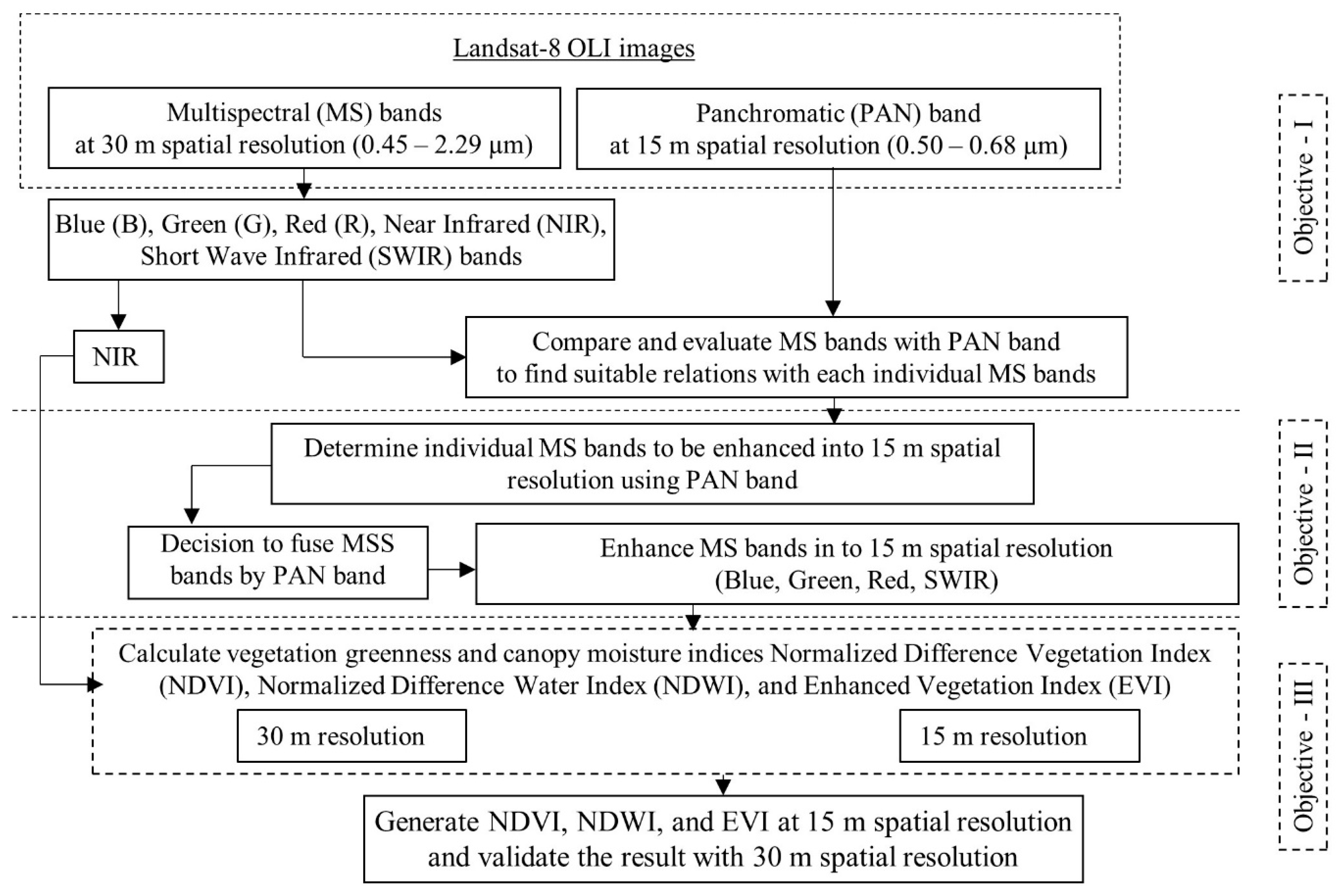

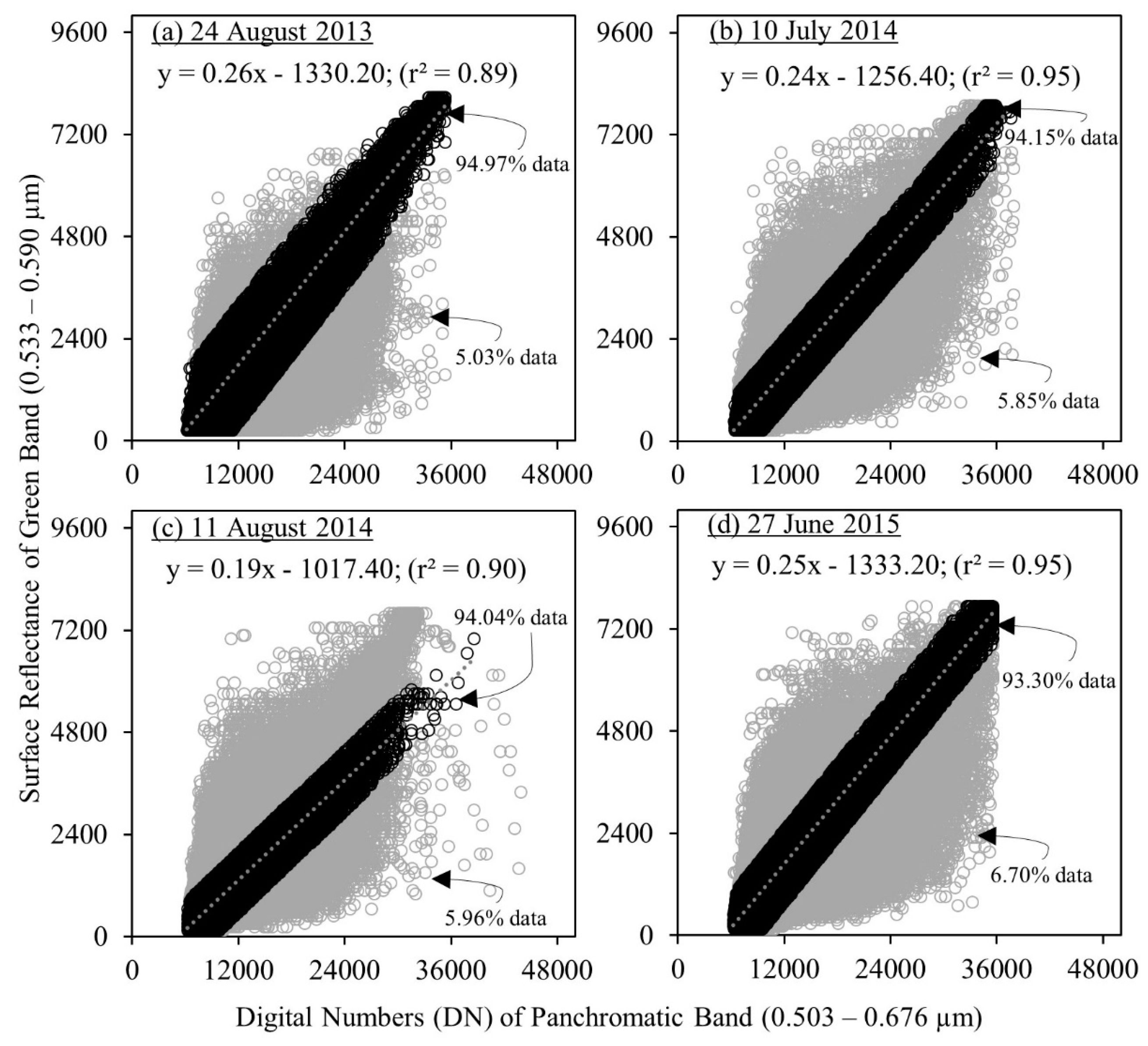

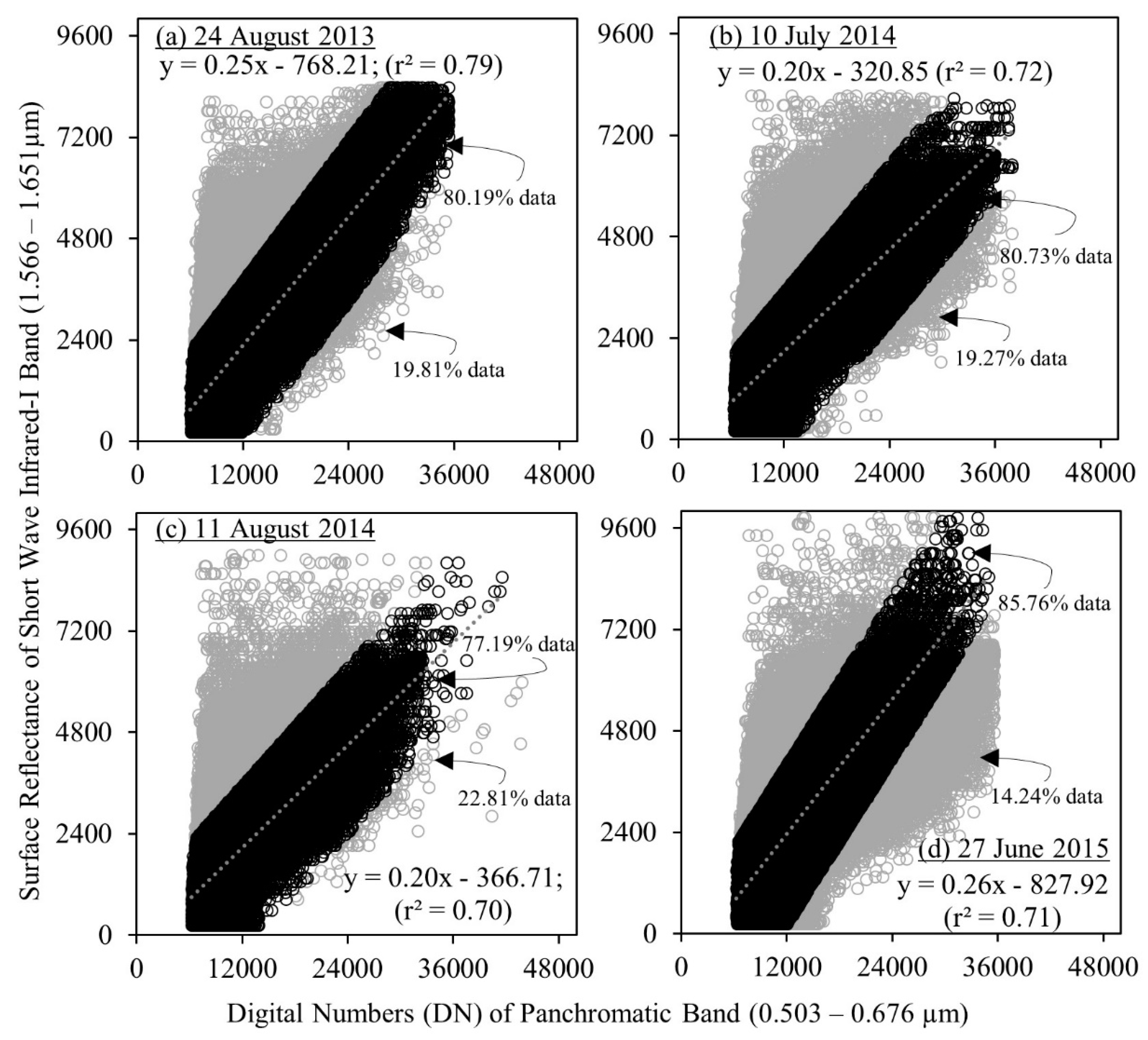


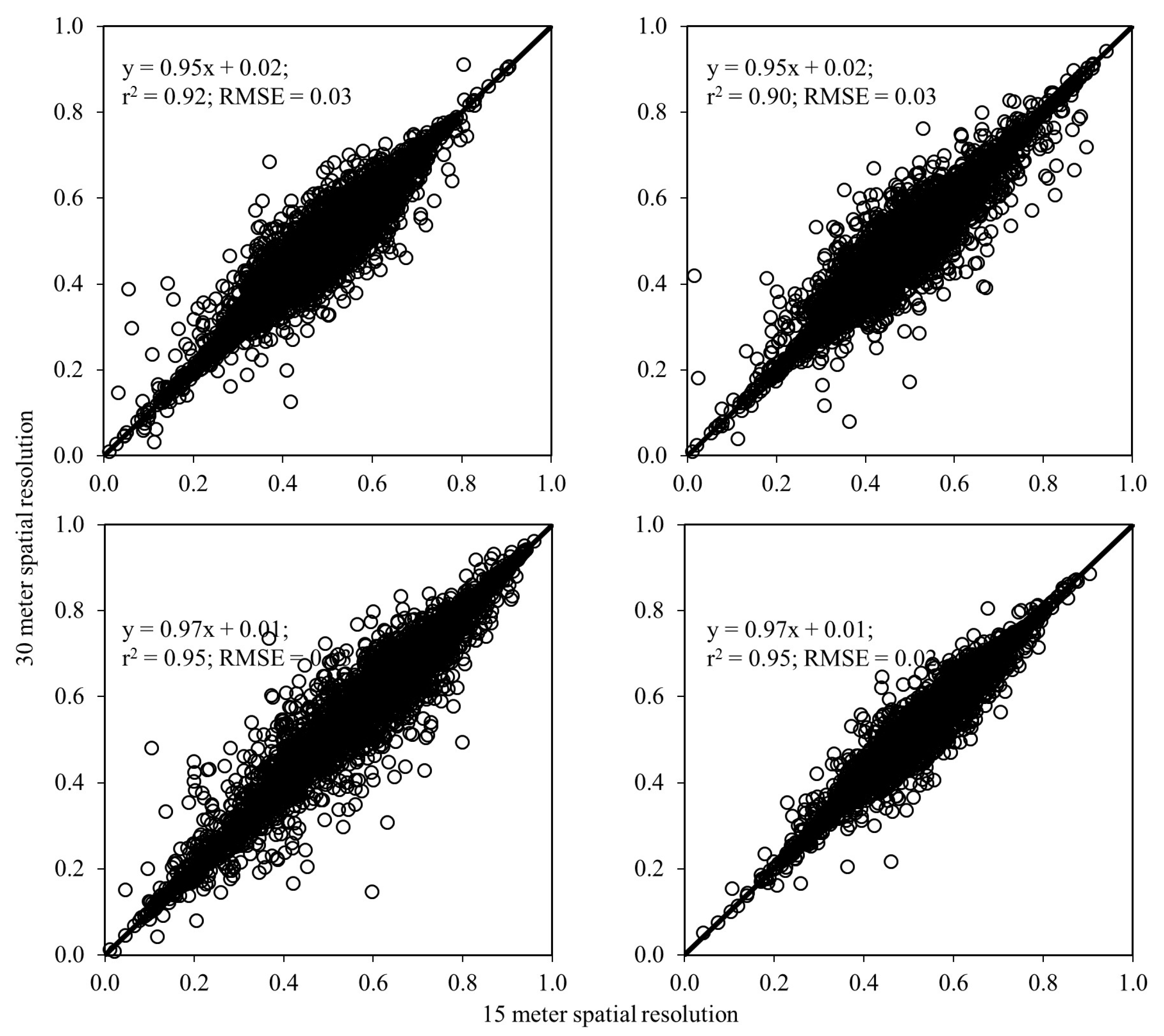

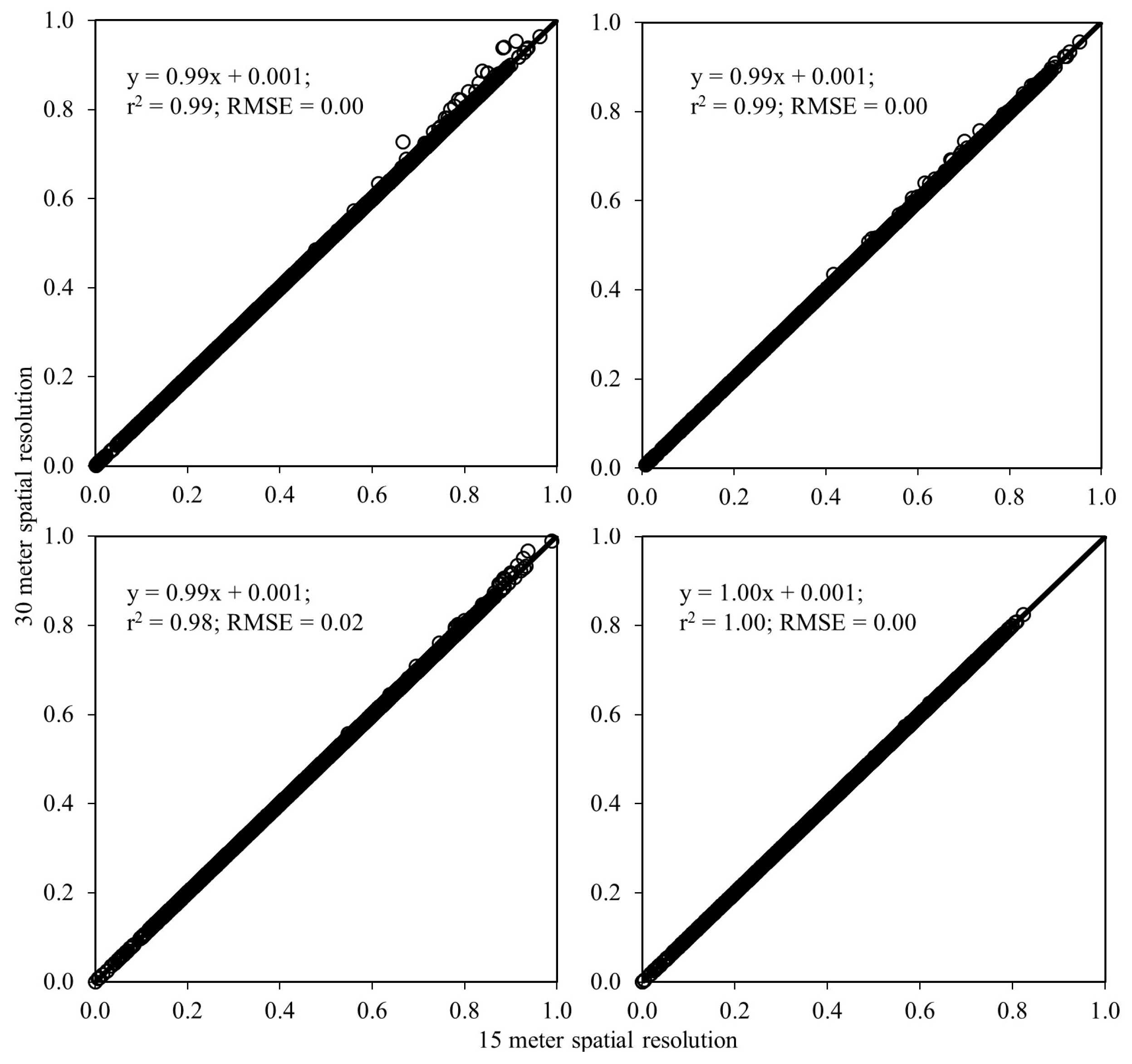
© 2017 by the authors. Licensee MDPI, Basel, Switzerland. This article is an open access article distributed under the terms and conditions of the Creative Commons Attribution (CC BY) license (http://creativecommons.org/licenses/by/4.0/).
Share and Cite
Rahaman, K.R.; Hassan, Q.K.; Ahmed, M.R. Pan-Sharpening of Landsat-8 Images and Its Application in Calculating Vegetation Greenness and Canopy Water Contents. ISPRS Int. J. Geo-Inf. 2017, 6, 168. https://0-doi-org.brum.beds.ac.uk/10.3390/ijgi6060168
Rahaman KR, Hassan QK, Ahmed MR. Pan-Sharpening of Landsat-8 Images and Its Application in Calculating Vegetation Greenness and Canopy Water Contents. ISPRS International Journal of Geo-Information. 2017; 6(6):168. https://0-doi-org.brum.beds.ac.uk/10.3390/ijgi6060168
Chicago/Turabian StyleRahaman, Khan Rubayet, Quazi K. Hassan, and M. Razu Ahmed. 2017. "Pan-Sharpening of Landsat-8 Images and Its Application in Calculating Vegetation Greenness and Canopy Water Contents" ISPRS International Journal of Geo-Information 6, no. 6: 168. https://0-doi-org.brum.beds.ac.uk/10.3390/ijgi6060168






